Parish History
Early History
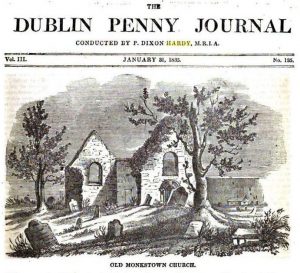 The first church in Monkstown was dedicated to St. Mochonna. According to the Martyrology of Tallaght, St Mochonna founded a monastery at Holmpatrick, Skerries. It appears that when the Danes sacked Holmpatrick in 798 AD, some of the monks escaped and established a monastery in the location now occupied by on old graveyard on the eastern side of Carrickbrennan Road.
The first church in Monkstown was dedicated to St. Mochonna. According to the Martyrology of Tallaght, St Mochonna founded a monastery at Holmpatrick, Skerries. It appears that when the Danes sacked Holmpatrick in 798 AD, some of the monks escaped and established a monastery in the location now occupied by on old graveyard on the eastern side of Carrickbrennan Road.
In the 12th century, the area was granted to the Cistercians. By the 12th century, the name used was Karrachbrenan. The topology of the area was quite different at that time. A river (shown on maps as “Micky Brien’s stream” and now culverted) flowed down the hill past the monastery, to meet another stream (also culverted adjacent to the present church), and to flow into a bay (now filled) near the Purty Kitchen. The coastline, which then had cliffs and salt deposits has been greatly modified by the construction of the railway and Dún Laoghaire harbour.
About 1250, Monkstown Castle was built nearby. On 28th Jun 1545, during Henry VIII’s reformation, the abbey was confiscated and passed into the hands of Sir John Travers (who is buried in the graveyard there), then owner of Monkstown Castle. Prior to the Cromwellian period, there are records of Monkstown having pleasant walks, well-laid gardens, and land stocked with sheep, cattle and horses. St Mochonna’s church was restored in 1668 as a protestant church. In 1785, the foundation stone for a new church at Monkstown was laid, and was enlarged in 1825 to form the present Church of Ireland in the village.
After the Reformation, a new Catholic parish was established in the area, and stretched from Seapoint to Little Bray to Three Rock mountain. The area was thinly populated, and was assigned to one priest. There are records of masses being celebrated in Monkstown Castle, and of a fine imposed on the owner for permitting these.
Open farmland becomes suburbia – St Patrick’s Church is built
The town of DunLeary developed within the confines of the present parish of Monkstown in the area around the Purty Kitchen, and from the early 1800s its population increased and its centre of gravity moved to the present Dún Laoghaire. In 1829 the parish of Kingstown (Dún Laoghaire) was established, and included the area of Monkstown. The coming of Ireland’s first railway, which originally terminated near the Purty Kitchen greatly accelerated the development of the area, and, in particular, gave rise to the construction of fashionable terraces, firstly at Montpelier Parade, then Longford Terrace, and then The Crescent and the various roads along the northern side of Monkstown Road. The southern side of Monkstown road was developed as luxury mansions, and the southern end of Monkstown was even more luxurious. There were major mansions in open parkland along Monkstown Avenue, and in the areas now occupied by Windsor Park, Brook Court, Ashton Park, Carrickbrennan Lawn, and the surrounding areas. Contemporary maps show a cricket pitch in the area just behind the church, where alma park is now
A site for a new church was bought at Broomwood, Monkstown, from the family of James Doherty. Two of the finest windows in the church are dedicated to the memory of the Doherty family. In 1861, the foundation stone for the present church was laid and was dedicated to St Patrick. It was the last of 5 churches commissioned by the same parish priest, Canon Sheridan, in the parish of Kingstown, but he died before completion. The new Parish Priest decided to change the plans, and commissioned George Ashlin to draw up new plans. The builder was Michael Meade. The tender price, excluding the spire, was £5,750. Fuller details of the construction can be found here.
The first marriage in the church was that of John Ormond and Martha Graham. The first baptism recorded in the register was that of Thomas Fitzgerald of Belgrave Square.
The spire of St Patrick’s was completed in 1881 and was paid for by Mr P Madden. The parochial house was built for the curate in 1892.
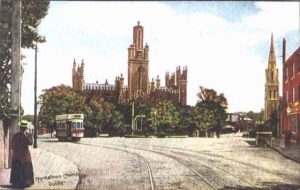
Monkstown in 1905. The picture seems to have been airbrushed, as a tram of this type would require overhead wires
Our Parish develops
Over a period of 90 years from the construction of St Patricks, Monkstown changed little. The 1948 ordnance survey map is almost identical to the 1870 map. The parish of Monkstown as a separate entity was established in 1902, with Fr Robert Eaton as Parish Priest, and two curates. This change was probably triggered by the growth of Dun Laoghaire rather than by any changes at Monkstown. The new Monkstown parish then was much larger than the present one, and included much of the area of Kill o the Grange.
In 1932, ecclesiastical events slightly reshaped the parish. In the preparation for the Eucharistic Congress of 1932, it was considered that the road through Monkstown was insufficient for the expected pilgrim traffic from the port of Dun Laoghaire. The coast road, including Seapoint Avenue was created, mainly by joining a number of cul-de-sacs, and by cutting through various gardens.
Until 1939, the majority of children from Monkstown walked to school in Dún Laoghaire. The Blessed Oliver Plunkett school, located behind the present Post Office was built for £4,986-6-4, with 1/3 of this amount being subscribed by the parish. In 1945, the Sacred Heart Convent School for girls was established on the site now occupied by Carrickbrennan Lawn. The school closed in 1977. In 1950, the Christian Brothers opened their four-classroom school for boys at Monkstown Park, and the school was extended in 1953, 1964 and 1987. In 1966, the Holy Family School at Dunedin Park was opened to accommodate 700 pupils. Following boundary changes in 1966 and 1972, this school is now in the parish of Kill o the Grange.
Significant renovation works were undertaken on the church on its centenary in 1966. A booklet entitled “Monkstown, The story of a parish” – by Maxwell Sweeney – was produced for the centenary, and can be downloaded in pdf format on the following link:
Parish History Booklet produced for the parish centenary 1966 -story
In 1972, the parish was divided, with the south-eastern section being constituted as the parish of Kill o the Grange.
In 1995, the Parish Centre was opened behind the church. Lands owned by the parish were sold to defray the costs. Alma Park was constructed on these lands, which had been a small farm until the 1970s.
In 1998, major renovation work was carried out on the stained glass windows.
Some prominent historical church figures associated with Monkstown
Venerable Edel Quinn, (1907-1944) lay missionary with the Legion of Mary in Dublin and Africa
Mother Mary Martin, foundress of the Medical Missionaries of Mary
References
Monkstown, The story of a parish – Maxwell Sweeney – Booklet produced for the centenary of St Patrick’s Church 1966
A short ecclesiastical history of Monkstown – Rev Vincent Quilter – included as Chapter 6 of The Book of Dun Laoghaire, Published by Blackrock Teachers Centre 1987
St Patricks Parish Centenary 1902-2002. Booklet produced by Rev. M O Moore, PP, 2002
Carrickbrennan Graveyard – Dun Laoghaire Borough Historical Society – Compiled by Joe English
Between the mountains and the sea – Peter Pearson (O Brien Press)
Monkstown – Eoin O Brien 1984 Downloadable here
Other things to know about Monkstown
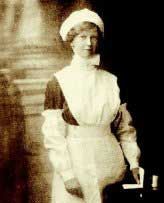 Mother Mary Martin, Foundress of Medical Missionaries of Mary Greenbank was a stately home on the site where Carrickbrennan Lawn is nowadays. The original 1911 census return for the Martin family can be seen here. It shows Marie H Martin, aged 18, living with her widowed mother and 5 young brothers all under 10.
Mother Mary Martin, Foundress of Medical Missionaries of Mary Greenbank was a stately home on the site where Carrickbrennan Lawn is nowadays. The original 1911 census return for the Martin family can be seen here. It shows Marie H Martin, aged 18, living with her widowed mother and 5 young brothers all under 10.
The family business was that of T & C Martin, in the joinery and hardware business. Marie Helena Martin, (left),later known as Mother Mary Martin (1892-1975), was a volunteer nurse during World War 1, then a lay missionary in Africa.
The process of forming a group of missionnary nuns was complex but by 1937 she had made her Profession of Vows. The Medical Missionaries of Mary now work in 16 countries.
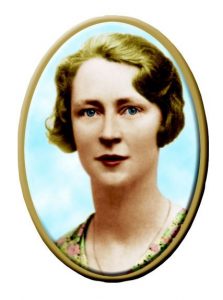 Another African Missionary Edel Quinn (1907-1944)
Another African Missionary Edel Quinn (1907-1944)
Edel was born near Kanturk, Co. Cork, where her father worked in the National Bank. Frequently transfers from town to town were the norm in banking in those days, before the family settled at Trafalgar Terrace in Monkstown in 1924.
She joined the Legion of Mary in Dublin. In 1936, in poor health, she went to Kenya, and established a local praesidium of the Legion. Over the subsequent years until her early death in 1944, she established the Legion in many African countries.
On December 15, 1994, Pope John Paul II declared Edel Quinn “Venerable”, and there is an active campaign for her beatification.
More details here
First Railway Sleepers in the World.
 Railway sleepers are those great big dirty blocks of wood on which railway tracks were laid. Nowadays they are replaced by concrete sleepers. Railway sleepers absorb much of the impact between trains and tracks, and were invented by William Dargan after he watched a blacksmith who put a block of wood under his anvil.
Railway sleepers are those great big dirty blocks of wood on which railway tracks were laid. Nowadays they are replaced by concrete sleepers. Railway sleepers absorb much of the impact between trains and tracks, and were invented by William Dargan after he watched a blacksmith who put a block of wood under his anvil.
As a result, Dargan named his house Mount Anville, and later sold it to the Sacred Heart nuns who established a school there. His first railway sleepers were on a six-mile of track from Dublin which terminated in Monkstown, near the Purty Kitchen.
The first locomotive to come into Monkstown was the “Hibernia” on Oct 5th 1834. For fuller details go to Mikes Railway History. William Dargan was Ireland’s greatest railway engineer. He was born in Ballyhide, on the Laois/Carlow border, and worked in England with George Stephenson, and with Thomas Telford before winning the contract for the Dublin-Kingstown railway.
Dargan had the very unusual experience of having a statue erected to him during his lifetime. It was shown at the Great Exhibition of 1853, and the illustration opposite is taken from The Illustrated Magazine of Art (New York 1953). The statue is now at the entrance to the National Gallery. Click the picture for a larger view. His grave is in Glasnevin cemetary.
Connections with Monkstown, Co. Cork.
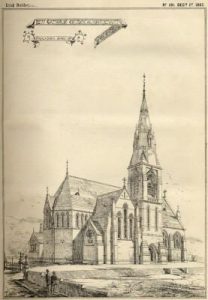 is a seaside village in Cork harbour Cork Harbour. It is near the town of Cobh, formerly called Queenstown. We are near its sister town, Dun Laoghaire, formerly called Kingstown.
is a seaside village in Cork harbour Cork Harbour. It is near the town of Cobh, formerly called Queenstown. We are near its sister town, Dun Laoghaire, formerly called Kingstown.
The Catholic Church of the Sacred Heart at Monkstown, Co. Cork was designed by Ashlin and Pugin in 1866, and the design was featured in The Irish Builder in 1867 (see opposite).
Our Catholic Church, St Patrick’s, was designed by Ashlin & Pugin, and opened in 1866. The 3rd Earl of Rosse, William Parsons (1800-1867), who built Leviathan, then the world’s largest telescope at Birr, was born and died in Monkstown, Cork. He had his Dublin house in Longford Terrace, Monkstown, Dublin
Charles Haliday
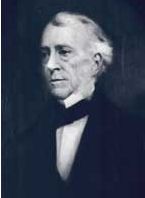 Charles Haliday influenced Joyce. James Joyce left Dublin in 1904, so much of his writing was done in Italy, Switzerland and France. He needed meticulous detail on Dublin for his writings, including Finnegans Wake, The Dead, and others. Some of this was provided by the writings of Charles Haliday (1789-1866)(left), medical practitioner, philanthropist, writer, and medical campaigner who lived in Monkstown.
Charles Haliday influenced Joyce. James Joyce left Dublin in 1904, so much of his writing was done in Italy, Switzerland and France. He needed meticulous detail on Dublin for his writings, including Finnegans Wake, The Dead, and others. Some of this was provided by the writings of Charles Haliday (1789-1866)(left), medical practitioner, philanthropist, writer, and medical campaigner who lived in Monkstown.
His house is within the grounds of the Christian Brothers College, Monkstown, and his grave is in Carrickbrennan Graveyard. His writings include The Scandinavian Kingdom of Dublin. Haliday died on the weekend of the dedication of St Patrick’s, and his funeral service at Monkstown Church of Ireland was held the next day.
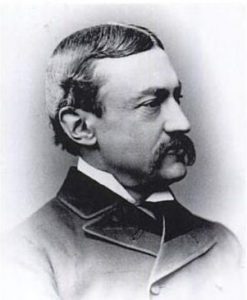 Sir Howard Grubb and the Periscope.
Sir Howard Grubb and the Periscope.
Although the principles of the periscope were well known beforehand, Sir Howard Grubb(right) (1844-1931) was the first to design a practical periscope for use in a wartime submarine during WW1. He had worked with his father’s firm, the Grubb Telescope Company, which helped to build the Leviathan, mentioned at no. 3 above. Grubb telescopes were also supplied to the Dunsink and Armagh observatories.
There is a plaque on his house at Longford Terrace, Monkstown. By the date of the 1911 census he was living in no 14 Orwell Road, Rathgar, and his census return can be seen here Census of Ireland 1911
First lady of Spectroscopy.
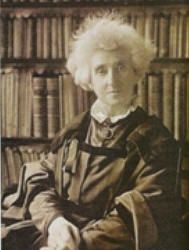 Dame Margaret Lindsay Huggins (nee Murray)(1848-1915) spent her childhood at 23 Longford Terrace, where she was a contemporary and neighbour of Sir Howard Grubb (above), where they they shared an interest in optical instruments. Margaret even constructed a small telescope herself to map stars by night and sunspots by day. Indeed, it is said that Grubb had a hand in bringing together Margaret and her future husband Sir William Huggins already a distinguished astronomer. They were married at Monkstown Church of Ireland on 8th Sept 1875. He was 51, she was 27.
Dame Margaret Lindsay Huggins (nee Murray)(1848-1915) spent her childhood at 23 Longford Terrace, where she was a contemporary and neighbour of Sir Howard Grubb (above), where they they shared an interest in optical instruments. Margaret even constructed a small telescope herself to map stars by night and sunspots by day. Indeed, it is said that Grubb had a hand in bringing together Margaret and her future husband Sir William Huggins already a distinguished astronomer. They were married at Monkstown Church of Ireland on 8th Sept 1875. He was 51, she was 27.
Although she often portrayed herself as her husband’s able assistant, it is now accepted that she was the main impetus behind a programme of photographic spectroscopy. Spectroscopy is the analysis of electromagnetic radiation (including visible light) to determine the properties of an astronomical object. Much of her work relates to the study of the Orion Nebula, which showed that the nebula consisted of gases rather than stars as previously believed.
Monkstown’s night of disasters.
Wednesday, November 18th 1807 was Monkstown’s night of disasters. In an horrific storm, two sailing ships, the Rochdale and the Prince of Wales were blown on to the rocks. The Prince of Wales was a sloop of 103 tons with a draught of 11 feet. It was built in Parkgate, Cheshire in 1787. The Captain was Captain Robert Jones of Liverpool and it was carrying the 97th regiment destined for foreign service in the British Empire.
The Rochdale was larger than the Prince of Wales. It was built in 1797 as a brig of 135 tons and a ten foot draught. The captain was Captain Hodgson. It was driven along a similar path as the Prince of Wales. It attempted to lay anchors but the cable snapped. On shore cries of the terrified passengers could be heard. As she swept past Dún Laoghaire, soldiers on board fired their muskets to attract attention. At Salthill, would-be rescuers had to shelter from the gunfire. Off Blackrock, blue lights were seen and gunfire heard. It stuck the rocks at the Seapoint Martello tower. A twelve foot plank would have rescued them, but all 265, including 42 women and 29 children, on board were lost. Their bodies were unrecognisable, being mutilated by the sea and the rocks.
About 400 lives in total were lost on that night, many of them washed up on the shore at Monkstown. The disaster was one of the factors which led to the building of Dun Laoghaire Harbour. Some of the victims were buried in Carrickbrennan graveyard.
For a picture of the Rochdale on the rocks at Seapoint, Click here
The Bird’s Nest & Mrs Whately.
The Birds Nest orphanage in York Road (now refurbished as offices) carries a large stone inscription of dedication to Mrs Whately and Mrs George Wade. Mrs Whately was the wife of Archbishop Whately, who was Church of Ireland Archbishop of Dublin from 1831-1863. Mrs George Wade was their daughter, Blanch. The actor Kevin Whately (best known as Inspector Morse’s sidekick) is a direct descendant. Archbishop Whately was a controversial reforming figure, and is generally regarded as having been the main driver behind the establishment of the national school system in Ireland, as well as having written many of the schoolbooks for use in both Britain and Ireland. He is also considered as the Founding Father of Economics in Ireland. He lived in Stillorgan.
Some Quotes from Archbishop Whately:-
“Happiness is no laughing matter”.
“What is the female of a mail coach? …A miscarriage”
“To a lady: “Madam, what is the difference between you and me? ….I can’t conceive”
from Eccentric Bishop Richard Whately of Redesdale -by Bryan McMahon ISBN 0-9549865-0-4
Castor and Pollux.
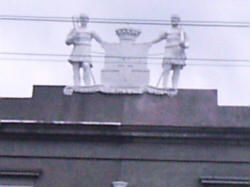 Next time that you are around deVesci Terrace, look up to roof level. There you will see life-size statues of Castor and Pollux (right), known in Greek mythology as the sons of Zeus, and in Roman mythology as twins who shared the same mother but different fathers, so that Castor was mortal, but Pollux was immortal. Castor and Pollux feature on the coat of arms of the DeVesci family, who were landlords of this area.
Next time that you are around deVesci Terrace, look up to roof level. There you will see life-size statues of Castor and Pollux (right), known in Greek mythology as the sons of Zeus, and in Roman mythology as twins who shared the same mother but different fathers, so that Castor was mortal, but Pollux was immortal. Castor and Pollux feature on the coat of arms of the DeVesci family, who were landlords of this area.
DeVesci was the title name, but he family name was Vesey, and some members of the family held the title Baron Knapton. Thus many of the roads in the area owe their names to the same family, deVesci, Vesey, and Knapton.
Lambert Puppet Theatre
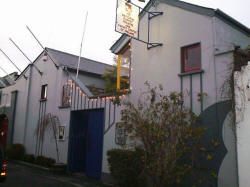 Located in Clifton Lane, 100 metres from the centre of the village, the Lambert Puppet Theatre is the only purpose-built puppet theatre in Ireland. In the 1960s, 70s, and early 80s, Eugene Lamberts puppets were a mainstay of children’s programming on RTE. Earlier, Eugene had done ventriloquism with his character Finnegan. In 1972, the Lambert family established the theatre in their own back garden. After Eugene Lambert, the theatre was run by his son, Liam.
Located in Clifton Lane, 100 metres from the centre of the village, the Lambert Puppet Theatre is the only purpose-built puppet theatre in Ireland. In the 1960s, 70s, and early 80s, Eugene Lamberts puppets were a mainstay of children’s programming on RTE. Earlier, Eugene had done ventriloquism with his character Finnegan. In 1972, the Lambert family established the theatre in their own back garden. After Eugene Lambert, the theatre was run by his son, Liam.
On August 28, 2015, it was badly damaged in an arson attack, which caused damage with a cost in excess of €150,000. On 13 November 2015, the theatre re-opened to the public with re-built puppets, for the Christmas performance of Aladdin, however this re-opening was not to last, and it closed permanently in 2018.
Radio Waves and the first sports commentary on radio
George F Fitzgerald (1851-1901), TCD physics professor was the first to suggest that an oscillating current in suitable circumstances would produce radio waves. His work, together with that of Maxwell and Hertz, laid the groundwork for Marconi’s wireless telegraphy. In 1898, in a collaboration between Marconi and Fitzgerald, the first sports commentary on radio took place at the Dun Laoghaire Regatta. His writings on the speed of light pre-date Einstein, and he attempted to fly a glider in TCD sports ground. He spent much of his youth in Monkstown, and his father was rector at Kill o the Grange. The Fitzgerald Crater on the Moon is named after him. It is 110km in diameter, with some sub-craters. Unfortunately, it is on the far side of the moon, never seen from earth, and only visible from satellites.